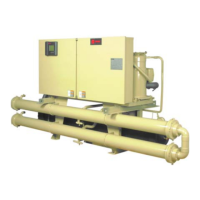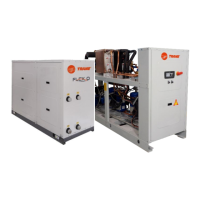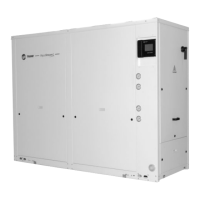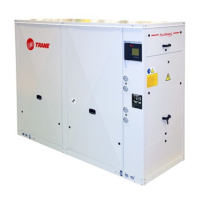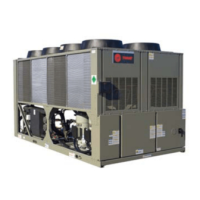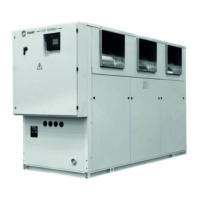7CGWH-SVX01D-E4
Installation
Refrigerant lines CCUH
Calculating and fixing the capacity
of refrigerant lines is necessary
to assure the oil return to the
compressor, avoid refrigerant phase
changes and limit pressure drop.
Liquid lines
Calculate capacity of liquid line, as
per the following criteria.
1. Maximum load operating
conditions.
2. To avoid any evaporation risk:
- Consider the vertical risers
- Maximum pressure drop must
not exceed 1 to 2°C
3. Liquid circulation speed in a 0.5
to 2m/s range.
Insulation of refrigerant lines
Insulate refrigerant lines from
building itself to avoid transmission
to building structure of vibrations
normally caused by pipework. Also
avoid bypassing the unit’s damping
system by fixing the refrigerant
lines or the electrical ducts very
rigidly.
Vibrations may propagate into
building structure through rigidly
fixed refrigerant lines.
Pressure tests. Leak detection
During operations, take the
following precaution:
1. Neither oxygen nor acethylene
should be used instead of
refrigerant and nitrogen to
detect leaks, otherwise a violent
explosion may occur.
2. Always use valves and
manometers to check the test
pressure in system. Excessive
pressure may either cause
pipes to rupture, damage unit,
or cause an explosion, causing
possible physical injury.
Carry out liquid line and hot gas
pressure tests in accordance
with current standards.
CAUTION!
Do not go more than 0.7 bar above
the high pressure switch setpoint.
Introduce enough refrigerant into
circuit for 85 to 100 kPa pressure,
pump-injecting dry nitrogen, and
raise pressure to 100 kPa. Search
possible leaks using detector. This
operation should be carried out
great care throughout the system.
If leaks are detected, reduce system
pressure, and repair defective
component. Repeat test process, to
check that the repair can withstand
rated pressure.
NOTE:
CCUH is delivered with a nitrogen
holding charge and isolating valves.
The minimum volume can be
determined by using the following
formula : Volume = Cooling capacity
x Time x highest capacity step (%) /
Specific heat / Dead band.
Minimum operating time
= 120 seconds.
Specific heat = 4.18 kj / kg.
Average deadband = 3°C (or 2°C)
Note: To estimate the biggest step,
it is usually more reliable to make
a selection at lower condensing
temperature where efficiency is
higher and compressor steps bigger.
It is also essential to take into
account the brine specific heat, in
case of the use of glycol.
Table 2 - CGWH
Unit size 115 120 125 225 230 235 240 250
Cooling Capacity (kW) 51 64 77 91 103 116 127 155
Biggest step (%) 50 60 50 42 38 34 30 25
Biggest step (kW) 26 38 39 38 39 39 38 39
Minimum water
loop for comfort
(l) 244 368 368 365 375 377 365 371
This table is estimated with
- Condenser : Water 30°/35°C
- Evaporator : Water 12°/7°C
- Dead Band of 3°C
Table 3 - CCUH
Unit size 115 120 125 225 230 235 240 250
Cooling Capacity (kW) 51 64 77 90 102 115 127 153
Biggest step (%) 50 60 50 42 38 34 30 25
Biggest step (kW) 26 38 38 38 39 39 38 38
Minimum water
loop for comfort
(l) 244 367 367 363 371 374 365 366
This table is estimated with
- Condensing temp : 45°C with sub cooling 5°C
- Evaporator : Water 12°/7°C
- Dead Band of 3°C
Note: CCUH is only one component of a complete installation. It includes its own high pressure protection set at
29.5 bars.
The party in charge of the supply of the condenser and of its refrigerant piping is responsible of implementing all
the required protections to comply with the PED requirements for the design pressure of the condenser installed.
Please refer to the document PROD-SVX01_-xx delivered with this chiller to check all the mandatory conformity
requirements of the Pressure Equipment and Machinery directives for this installation.
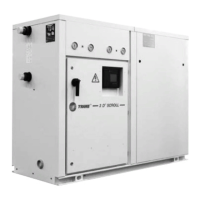
